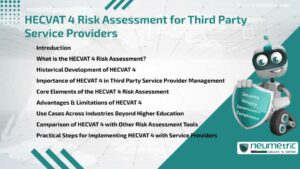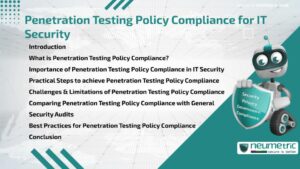Table of Contents
ToggleIntroduction
Penetration Testing Policy Compliance is the process of ensuring that Penetration Tests are performed in alignment with Regulatory requirements, Industry Standards & Internal Policies. By adhering to these Policies, organisations strengthen IT Security, identify Vulnerabilities before attackers Exploit them & demonstrate Accountability to Regulators & Stakeholders. This article explains Penetration Testing Policy Compliance, Why it matters, Key Steps, Challenges, Comparisons & Best Practices.
What is Penetration Testing Policy Compliance?
Penetration Testing Policy Compliance refers to the Structured approach of conducting Simulated Cyberattacks under formal Guidelines. Compliance ensures Tests are documented, authorised & carried out in line with Standards such as PCI DSS or ISO 27001. Much like safety inspections in Engineering, Penetration Testing Policy Compliance verifies Security Controls while meeting Regulatory expectations.
Importance of Penetration Testing Policy Compliance in IT Security
This Compliance Practice is essential for several reasons:
- Risk Identification: Uncovers Vulnerabilities before Malicious Actors do.
- Regulatory Alignment: Satisfies Legal requirements in Sectors such as Finance & Healthcare.
- Customer Confidence: Demonstrates proactive Security Management.
- Operational Strength: Ensures Security Strategies are effective & up to date.
Without Penetration Testing Policy Compliance, organisations Risk Fines, Breaches & Reputational harm.
Practical Steps to achieve Penetration Testing Policy Compliance
Organisations can achieve Compliance by:
- Defining Scope: Establish boundaries for Systems & Applications under Test.
- Authorisation: Obtain written approvals before initiating Tests.
- Standardised Procedures: Follow recognised Frameworks like NIST or OWASP.
- Documentation: Record Results & Remediation efforts to prove Compliance.
- Regular Testing: Schedule Penetration Tests annually or after major System changes.
For additional guidance, see this NIST Penetration Testing resource.
Challenges & Limitations of Penetration Testing Policy Compliance
Challenges include:
- Resource Constraints: Skilled Testers & Tools can be costly.
- Complex Environments: Cloud & Hybrid Systems complicate scoping.
- Regulatory Overlap: Meeting multiple Frameworks adds Administrative work.
- False Sense of Security: Overreliance on a single test may overlook ongoing Threats.
These limitations highlight the need for Continuous Improvement beyond Compliance.
Comparing Penetration Testing Policy Compliance with General Security Audits
While general Security Audits assess Policies, Configurations & Processes, Penetration Testing Policy Compliance focuses specifically on Simulated Attacks. A Security Audit is like reviewing a Car’s Maintenance Records, while Penetration Testing is a road test under challenging Conditions. Both are complementary but serve different purposes in IT Security.
See more insights in this ISACA Audit resource.
Best Practices for Penetration Testing Policy Compliance
Best Practices include:
- Partnering with Certified Penetration Testers.
- Incorporating Tests into Risk Management strategies.
- Communicating findings transparently with Stakeholders.
- Regularly updating Policies to align with evolving Regulations.
These practices ensure Penetration Testing Policy Compliance becomes an ongoing commitment rather than a One-time task.
Conclusion
Penetration Testing Policy Compliance is a cornerstone of IT Security. By adhering to defined Policies, organisations not only meet Regulatory demands but also strengthen defences against Cyber Threats. Through Practical Steps & Best Practices, Compliance evolves into a proactive shield that reduces Risks & Builds Trust.
Takeaways
- Penetration Testing Policy Compliance aligns testing with Regulations & Standards.
- It identifies Risks, supports Customer Trust & Improves Operations.
- Key steps include Scoping, Authorisation & Documentation.
- Challenges include Costs, Complexity & Overlapping Frameworks.
- Best Practices turn Compliance into an ongoing Security Culture.
FAQ
What is Penetration Testing Policy Compliance?
It is the process of conducting Penetration Tests in line with Regulations, Standards & Internal Policies.
Why is Penetration Testing Policy Compliance important?
It uncovers Risks, satisfies Regulators & builds Customer confidence.
How often should Penetration Testing Policy Compliance be reviewed?
At least annually or after major IT System changes.
What challenges do organisations face with Penetration Testing Policy Compliance?
Costs, complex environments & overlapping Frameworks are common challenges.
How does Penetration Testing Policy Compliance differ from a general Security Audit?
Compliance focuses on Simulated Attacks, while Audits review broader Policies & Controls.
References
- PCI DSS – Security Standards
- ISO – ISO 27001 Information Security
- NIST – CyberSecurity Publications
- ISACA – Penetration Test Definition
- OWASP – Penetration Testing Resources
Need help for Security, Privacy, Governance & VAPT?
Neumetric provides organisations the necessary help to achieve their CyberSecurity, Compliance, Governance, Privacy, Certifications & Pentesting needs.
Organisations & Businesses, specifically those which provide SaaS & AI Solutions in the Fintech, BFSI & other regulated sectors, usually need a CyberSecurity Partner for meeting & maintaining the ongoing Security & Privacy needs & requirements of their Enterprise Clients & Privacy conscious Customers.
SOC 2, ISO 27001, ISO 42001, NIST, HIPAA, HECVAT, EU GDPR are some of the Frameworks that are served by Fusion – a SaaS, multimodular, multitenant, centralised, automated, CyberSecurity & Compliance Management System.
Neumetric also provides Expert Services for technical Security which covers VAPT for Web Applications, APIs, iOS & Android Mobile Apps, Security Testing for AWS & other Cloud Environments & Cloud Infrastructure & other similar scopes.
Reach out to us by Email or filling out the Contact Form…





